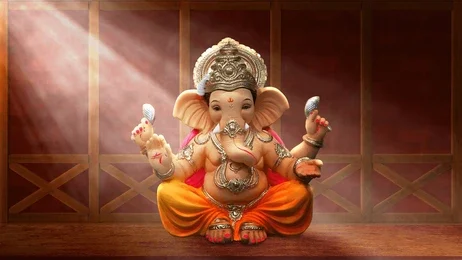Ganesh, also known as Ganesha or Ganapati, is one of the most important and revered deities in Hinduism. His significance extends beyond religion into various aspects of life and culture. Here’s a detailed look at his significance:

1. Iconography and Symbolism:
- Elephant Head: Ganesh’s elephant head symbolizes wisdom, understanding, and a discerning mind. The elephant’s large ears signify an ability to listen and absorb information, while the trunk represents flexibility and strength. The elephant is also a symbol of prosperity and good fortune.
- Human Body: The human body of Ganesh signifies his connection to humanity, making him accessible and relatable to his devotees.
- Multiple Arms: Ganesh is commonly depicted with four arms, though the number can vary. Each arm holds symbolic items:
- Modak: A sweet dumpling, representing the rewards of a disciplined life.
- Axe: Symbolizing the power to cut through obstacles and distractions.
- Lotus: A symbol of purity, enlightenment, and the unfolding of spiritual knowledge.
- Rope: Used to pull devotees towards their goals and aspirations.
- Large Belly: Represents the ability to digest all experiences, both pleasant and unpleasant, with equanimity. It also signifies abundance and the ability to encompass all experiences in life.
2. Mythological Origins and Stories:
- Creation: According to one popular legend, Ganesh was created by the goddess Parvati from the turmeric paste she used for her bath. She gave him life and instructed him to guard her while she bathed. When Shiva, her husband, arrived and was denied entry by Ganesh, a conflict ensued, leading to Ganesh’s head being replaced with that of an elephant.
- Conflict with Shiva: In another version of the story, Ganesh was beheaded by Shiva’s followers during a misunderstanding. To restore him to life, Shiva replaced his head with that of an elephant, and Ganesh was thereafter honored with the position of leader of the Ganas (Shiva’s followers).
- The Broken Tusk: Ganesh is often depicted with a broken tusk, which is associated with a legend where he broke it off to use as a pen to write down the Mahabharata epic, dictated by the sage Vyasa.
3. Roles and Attributes:
- Remover of Obstacles (Vigneshwara): Ganesh is widely known as Vigneshwara, or the remover of obstacles. This attribute makes him a deity to be worshipped before beginning any new project, journey, or endeavor to ensure success and smooth progress.
- Patron of Arts and Sciences: As the god of intellect and learning, Ganesh is revered by students, scholars, and artists. He is believed to bestow wisdom and knowledge and to help in overcoming intellectual challenges.
- Symbol of Prosperity and Well-being: Ganesh is also associated with material success and prosperity. His blessings are sought for financial stability, good fortune, and general well-being.
4. Worship and Rituals:

- Ganesh Chaturthi: This major Hindu festival celebrates Ganesh’s birth and is observed with great fervor, particularly in Maharashtra. The festival involves installing Ganesh idols in homes and public spaces, performing elaborate rituals, and concluding with a procession to immerse the idols in water.
- Daily Worship: Ganesh is worshipped in homes and temples with offerings of sweets, flowers, and prayers. His mantra, “Om Gan Ganapataye Namah,” is commonly recited during worship.
- Special Occasions: Besides Ganesh Chaturthi, Ganesh is honored during various other festivals and occasions, such as Sankashti Chaturthi, an auspicious day dedicated to him each month, and Vinayaka Chaturthi.
5. Cultural and Global Impact:
- Cultural Integration: Ganesh’s image and symbolism have transcended Hinduism and are embraced in various cultural contexts worldwide. His iconography is popular in art, literature, and design.
- Symbol of Unity: Ganesh’s role as a remover of obstacles and his universal appeal make him a symbol of harmony and unity across different cultures and traditions.
- Art and Popular Culture: Ganesh is frequently featured in contemporary art and popular culture, including films, literature, and even business logos, reflecting his widespread influence.
6. Philosophical Significance:

- Embodiment of the Divine: Ganesh represents the principle of divine grace that helps remove both spiritual and material obstacles. His worship encourages devotees to overcome challenges with resilience and faith.
- Symbol of Transformation: Ganesh’s ability to adapt and transform obstacles into opportunities symbolizes the transformative power of spiritual practice and the importance of a positive mindset.
Ganesh’s multifaceted symbolism, rich mythology, and widespread worship underscore his significance not only as a deity but also as a cultural icon representing wisdom, prosperity, and the triumph over obstacles.
